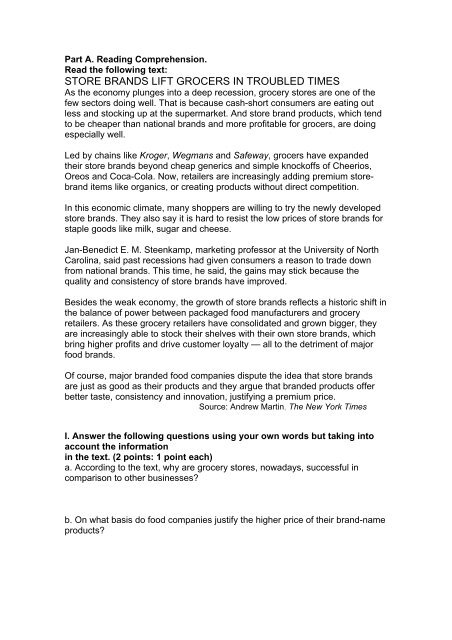Store brands lift grocers in troubled times
Store brands lift grocers in troubled times
Store brands lift grocers in troubled times
Create successful ePaper yourself
Turn your PDF publications into a flip-book with our unique Google optimized e-Paper software.
Part A. Read<strong>in</strong>g Comprehension.<br />
Read the follow<strong>in</strong>g text:<br />
STORE BRANDS LIFT GROCERS IN TROUBLED TIMES<br />
As the economy plunges <strong>in</strong>to a deep recession, grocery stores are one of the<br />
few sectors do<strong>in</strong>g well. That is because cash-short consumers are eat<strong>in</strong>g out<br />
less and stock<strong>in</strong>g up at the supermarket. And store brand products, which tend<br />
to be cheaper than national <strong>brands</strong> and more profitable for <strong>grocers</strong>, are do<strong>in</strong>g<br />
especially well.<br />
Led by cha<strong>in</strong>s like Kroger, Wegmans and Safeway, <strong>grocers</strong> have expanded<br />
their store <strong>brands</strong> beyond cheap generics and simple knockoffs of Cheerios,<br />
Oreos and Coca-Cola. Now, retailers are <strong>in</strong>creas<strong>in</strong>gly add<strong>in</strong>g premium storebrand<br />
items like organics, or creat<strong>in</strong>g products without direct competition.<br />
In this economic climate, many shoppers are will<strong>in</strong>g to try the newly developed<br />
store <strong>brands</strong>. They also say it is hard to resist the low prices of store <strong>brands</strong> for<br />
staple goods like milk, sugar and cheese.<br />
Jan-Benedict E. M. Steenkamp, market<strong>in</strong>g professor at the University of North<br />
Carol<strong>in</strong>a, said past recessions had given consumers a reason to trade down<br />
from national <strong>brands</strong>. This time, he said, the ga<strong>in</strong>s may stick because the<br />
quality and consistency of store <strong>brands</strong> have improved.<br />
Besides the weak economy, the growth of store <strong>brands</strong> reflects a historic shift <strong>in</strong><br />
the balance of power between packaged food manufacturers and grocery<br />
retailers. As these grocery retailers have consolidated and grown bigger, they<br />
are <strong>in</strong>creas<strong>in</strong>gly able to stock their shelves with their own store <strong>brands</strong>, which<br />
br<strong>in</strong>g higher profits and drive customer loyalty — all to the detriment of major<br />
food <strong>brands</strong>.<br />
Of course, major branded food companies dispute the idea that store <strong>brands</strong><br />
are just as good as their products and they argue that branded products offer<br />
better taste, consistency and <strong>in</strong>novation, justify<strong>in</strong>g a premium price.<br />
Source: Andrew Mart<strong>in</strong>, The New York Times<br />
I. Answer the follow<strong>in</strong>g questions us<strong>in</strong>g your own words but tak<strong>in</strong>g <strong>in</strong>to<br />
account the <strong>in</strong>formation<br />
<strong>in</strong> the text. (2 po<strong>in</strong>ts: 1 po<strong>in</strong>t each)<br />
a. Accord<strong>in</strong>g to the text, why are grocery stores, nowadays, successful <strong>in</strong><br />
comparison to other bus<strong>in</strong>esses?<br />
b. On what basis do food companies justify the higher price of their brand-name<br />
products?
II. Are the follow<strong>in</strong>g statements true (T) or false (F)? Identify the part of the<br />
text that supports your answer by copy<strong>in</strong>g the exact passage on the<br />
answer sheet. (1.5 po<strong>in</strong>t: 0.5 each)<br />
a. National <strong>brands</strong> are usually more profitable for <strong>grocers</strong> than store <strong>brands</strong>.<br />
b. Shoppers f<strong>in</strong>d it difficult to resist buy<strong>in</strong>g store brand milk and sugar.<br />
c. Major food manufacturers claim their products are as good as store <strong>brands</strong>.<br />
III. F<strong>in</strong>d a synonym for each of the four words below from these six<br />
options: (1 po<strong>in</strong>t: 0.25 each)<br />
Plunges retailers staple trade down stick products<br />
a. merchants who sell goods directly to the consumers<br />
b. stay, rema<strong>in</strong><br />
c. drops steeply<br />
d. basic, essential, necessary<br />
IV. Choose a, b, or c, <strong>in</strong> each question below. Only one choice is correct.<br />
(1.5 po<strong>in</strong>ts: 0.5 each)<br />
1. Nowadays, consumers are short of cash; as a result, they…<br />
a. l<strong>in</strong>e up at supermarkets to get groceries.<br />
b. go to restaurants less frequently.<br />
c. eat less than before the recession.<br />
2. Food cha<strong>in</strong>s like Wegmans…<br />
a. are <strong>in</strong>troduc<strong>in</strong>g more quality store-brand products.<br />
b. are expand<strong>in</strong>g by open<strong>in</strong>g more stores.<br />
c. have decreased the amount of generics.<br />
3. Accord<strong>in</strong>g to the text, the growth of store <strong>brands</strong> reflects<br />
a. the consolidation of grocery retailers <strong>in</strong> detriment of major food<br />
manufacturers.<br />
b. customers’ loyalty to national <strong>brands</strong>.<br />
c. the power of national manufacturers.<br />
Part B. Write a 130 to 150-word composition. (4 po<strong>in</strong>ts)<br />
How has the f<strong>in</strong>ancial crisis affected daily life <strong>in</strong> Spa<strong>in</strong>?
STORE BRANDS LIFT GROCERS IN TROUBLED TIMES<br />
I. Answer the follow<strong>in</strong>g questions us<strong>in</strong>g your own words but tak<strong>in</strong>g <strong>in</strong>to account the<br />
<strong>in</strong>formation <strong>in</strong> the text. (2<br />
po<strong>in</strong>ts: 1 po<strong>in</strong>t each)<br />
a. Accord<strong>in</strong>g to the text, why are grocery stores, nowadays, successful <strong>in</strong> comparison to other<br />
bus<strong>in</strong>esses? PAR. 1<br />
b. On what basis do food companies justify the higher price of their brand-name products?<br />
PAR. 6<br />
II. Are the follow<strong>in</strong>g statements true (T) or false (F)? Identify the part of the text that<br />
supports your answer by<br />
copy<strong>in</strong>g the exact passage on the answer sheet. (1.5 po<strong>in</strong>t: 0.5 each)<br />
a. National <strong>brands</strong> are usually more profitable for <strong>grocers</strong> than store <strong>brands</strong>. F<br />
And store brand products, which tend to be cheaper than national <strong>brands</strong> and more profitable<br />
for <strong>grocers</strong>, are do<strong>in</strong>g<br />
especially well.<br />
b. Shoppers f<strong>in</strong>d it difficult to resist buy<strong>in</strong>g store brand milk and sugar. T<br />
They also say it is hard to resist the low prices of store <strong>brands</strong> for staple goods like milk, sugar<br />
and cheese.<br />
c. Major food manufacturers claim their products are as good as store <strong>brands</strong>. F<br />
…major branded food companies dispute the idea that store <strong>brands</strong> are just as good as their<br />
products<br />
III. F<strong>in</strong>d a synonym for each of the four words below from these six options: (1 po<strong>in</strong>t: 0.25<br />
each)<br />
plunges retailers staple trade down stick products<br />
a. merchants who sell goods directly to the consumers _ retailers<br />
b. stay, rema<strong>in</strong> _ stick<br />
c. drops steeply _ plunges<br />
d. basic, essential, necessary _ staple<br />
IV. Choose a, b, or c, <strong>in</strong> each question below. Only one choice is correct. (1.5 po<strong>in</strong>ts: 0.5<br />
each)<br />
1. Nowadays, consumers are short of cash; as a result, they…<br />
a. l<strong>in</strong>e up at supermarkets to get groceries.<br />
b. go to restaurants less frequently. √<br />
c. eat less than before the recession.<br />
2. Food cha<strong>in</strong>s like Wegmans…<br />
a. are <strong>in</strong>troduc<strong>in</strong>g more quality store-brand products. √<br />
b. are expand<strong>in</strong>g by open<strong>in</strong>g more stores.<br />
c. have decreased the amount of generics.<br />
3. Accord<strong>in</strong>g to the text, the growth of store <strong>brands</strong> reflects<br />
a. the consolidation of grocery retailers <strong>in</strong> detriment of major food manufacturers. √<br />
b. customers’ loyalty to national <strong>brands</strong>.<br />
c. the power of national manufacturers.



